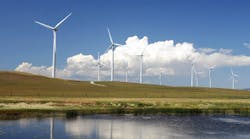How many times have we heard the power grid is in transition or grid-wise technology is transforming the industry? These terms and others like them come up regularly as we struggle with all the technologies being deployed to modernize the power delivery system. One of the most complex of these transitioning points is the move from fossil-fuel powered generation to clean renewables, and it’s happening at a faster pace every year.
According to the U.S. Energy Information Administration renewable generation surpassed coal-fired generation in the U.S. last year. Globally CNBC reported that 12% of the world’s electricity came from wind and solar generation in 2022. This record growth has focused a lot of attention on the bulk transmission system’s ability to connect this flood of renewables. Of particular interest is the massive backlog within the interconnection queue process that seems endless.
It’s estimated that there are currently about 2,000 gigawatts of wind, solar, and storage in the queue. Late last year FERC (Federal Energy Regulatory Commission) announced it was working with PJM, an RTO (regional transmission organization), on a systematic approach to streamline the interconnection process. They are exploring fast-lane methods along with several other schemes. This promises to be a step in the right direction, but it’s going to take time and time is one thing the transition is short on.
Digging Deeper
The queueing issues are going to be solved, but we still need a flexible and resilient bulk transmission system. That brings us back to digital technology in the form of power electronics. Power electronics is very much like standard electronics with the exception that it operates more robustly (i.e., kilo-volts, kilo-currents, and megawatts), and that is just what is needed!
It is everything that high-voltage alternating current (HVAC) is not when it comes to pushing power. The power grid’s transmission technology of choice has been HVAC, but HVDC (high-voltage direct current) is gaining ground. When HVAC moves massive blocks of power extremely long distances some of the laws of physics get in the way. And as Star Trek taught us, “ye cannae change the laws of physics.” Of course it is possible to bend those laws somewhat with VAr (volt-ampere reactive) compensation, but that too has its limitations.
The simplest solution would be to keep the distances short and the power transfer at lower levels, but that isn’t always possible. Contemporary windfarm projects are pushing multiple gigawatt ranges and potential project locations are more remote than ever. Those wind-rich sites that were close to existing transmission lines for the most part have been taken by the older windfarms. You might say, the “low hanging fruit” has been harvested and that is why we need a transmission technology with a different twist!
The Technology Option
The modular voltage source converter (VSC) is the latest generation of HVDC transmission technology and it’s exactly what the non-utility transmission developers require for an economic power delivery system. VSC-based HVDC point-to-point interregional transmission projects can be customized for maximum flexibility. The technology has evolved to the point that supplying enormous amounts of power over immense distances isn’t a problem. They can utilize overhead, underground, submarine, or a combination when constructing VSC-based HVDC links.
Recently Pattern Energy announced it had selected Hitachi Energy to supply the VSC-based HVDC and other advanced technologies needed for the SunZia Transmission Project. The SunZia transmission project is a 550 mile (885 kilometer), ±525 kilovolt (kV) high-voltage HVDC transmission line connecting the 3,500 megawatt (MW) SunZia Wind Project in central New Mexico (NM) to the 500 kV AC bulk power transmission grid in south-central Arizona.
The HVDC transmission line will have the capacity to transport 3,000 MW of clean, renewable energy. The SunZia Transmission project will be among the largest VSC-based HVDC transmission links in the world delivering power when completed. This project presents some amazing engineering solutions unique to this HVDC link. Charging Ahead contacted Andreas Berthou, global head of HVDC at Hitachi Energy to discuss Hitachi Energy’s customized engineering solutions for the SunZia Transmission project.
Berthou began the discussion saying, “Worldwide there is a strong trend between renewable energy and HVDC transmission. NM boasts some of the most abundant, constant wind energy resource in the United States. This resource is currently trapped due to the lack of transmission infrastructure and the SunZia Transmission project will carry this vast resource to areas with high long-term demand for power, delivering fuel-free, affordable energy to Arizona and the Southwestern United States.”
Berthou explained, “Hitachi Energy is supplying the VSC-based HVDC converter stations for the transmission link and will also supply AC chopper (editor’s note, AC-AC voltage control converter) technology to the project. Chopper technology is necessary to help restore power if the power flow on the HVDC line or in the AC grid in Arizona is temporarily interrupted by weather and other contingency events. The choppers will be installed at the sending end of the SunZia Transmission Project in NM and connected to the new 345 kV AC switchyard for the wind power collection system, which is islanded from the existing power grid in NM.”
Berthou continued, “These choppers are installed for the purpose of absorbing the power generated by the SunZia wind farms when the power transfer on the transmission line is disrupted by temporary faults. They will be utilized for fault clearing on either the SunZia HVDC transmission line or in the receiving end’s AC network in Arizona. In addition, the choppers aid during permanent faults on one pole during bipolar operation by giving the wind farm’s controls time to rebalance the power output from the wind-turbine generators with the remaining transmission capacity on the HVDC transmission link.”
Berthou said, “Clearing faults on the HVDC transmission line or at the receiving AC network in Arizona can be a serious problem. Faults are capable of temporarily disrupting the delivery of the windfarm’s power to the Arizona AC network, which can cause overvoltage conditions. The temporary imbalance between the power output from the windfarm and the power transmitted to Arizona causes a rapid rise of the DC voltage. It must be mitigated immediately by the braking resistor banks in the choppers. They absorb the power output from the windfarm and prevent severe DC overvoltage conditions. This allows the VSC-based HVDC converter stations to ride through the clearing of temporary faults. The activation of the chopper’s braking resistor banks is performed by the HVDC scheme’s control system.”
Berthou clarified, “The design of the thyristor controlled braking resistors (“TCBR”) is based on Hitachi Energy’s proven SVC (static VAr compensator) technology. The TCBR capacity will be divided into two identical and independent chopper units. Each chopper unit is connected to the 345 kV AC switchyard via dedicated AC feeder lines (one AC feeder line for each chopper) and have a dynamic capability of up to 1,500 MW for two seconds. The VSC-based HVDC converter stations and associated technologies are expected to be in service by the end of 2025 to support final testing and commissioning of the SunZia Wind facilities in 2026.”
HVDC’s Expanding Technology
In addition to the SunZia Transmission project Hitachi Energy is working on the Champlain Hudson Power Express VSC-HVDC project. It represents a totally different challenge for moving 1,250 MW more than 370 miles (600 km). Rather than repeat the details, see January 2023, "Charging Ahead" (https://tdworld.com/21255605) for the entire story.
Another challenging non-utility transmission developer project is the TransWest Express Transmission project. A few months ago, the Bureau of Land Management issued a notice to proceed with the transmission project. TransWest Express LLC has selected Siemens Energy to supply the HVDC transmission technology for the 732 mile (1,178 km) 3,000 MW transmission system running from south-central Wyoming to the Marketplace Hub about 25 miles (40 km) south of Las Vegas, Nevada.
Earlier this year SkyQuest Technology published its HVDC Converter Market report. It estimates the HVDC converter market will attain a value of US$ 20.60 billion by 2030. This is happening because the demand for HVDC converter technology is growing. It’s being driven by the demand for efficient and reliable power transmission systems pushed by renewable energy developers needing to move “enormous amounts of electrical power over vast distances.” This should be good news for VSC-based HVDC suppliers like GE, Hitachi Energy, Toshiba, Mitsubishi, and Siemens Energy to name a few.
Berkley Labs says, “the grid of the future looks sunny and windy,” which means there are going to be a lot more opportunities for interregional transmission interconnections. Since a VSC-based HVDC transmission line can transmit about three times more power than an AC line of equivalent voltage, there is a strong argument to utilize VSC-HVDC technology for these point-to-point links. It’s possible to build these links along road and rail rights-of-way. They can go overhead, underground, or submarine as required. VSC-HVDC is flexible, reliable, and ready to move clean-energy to market!


